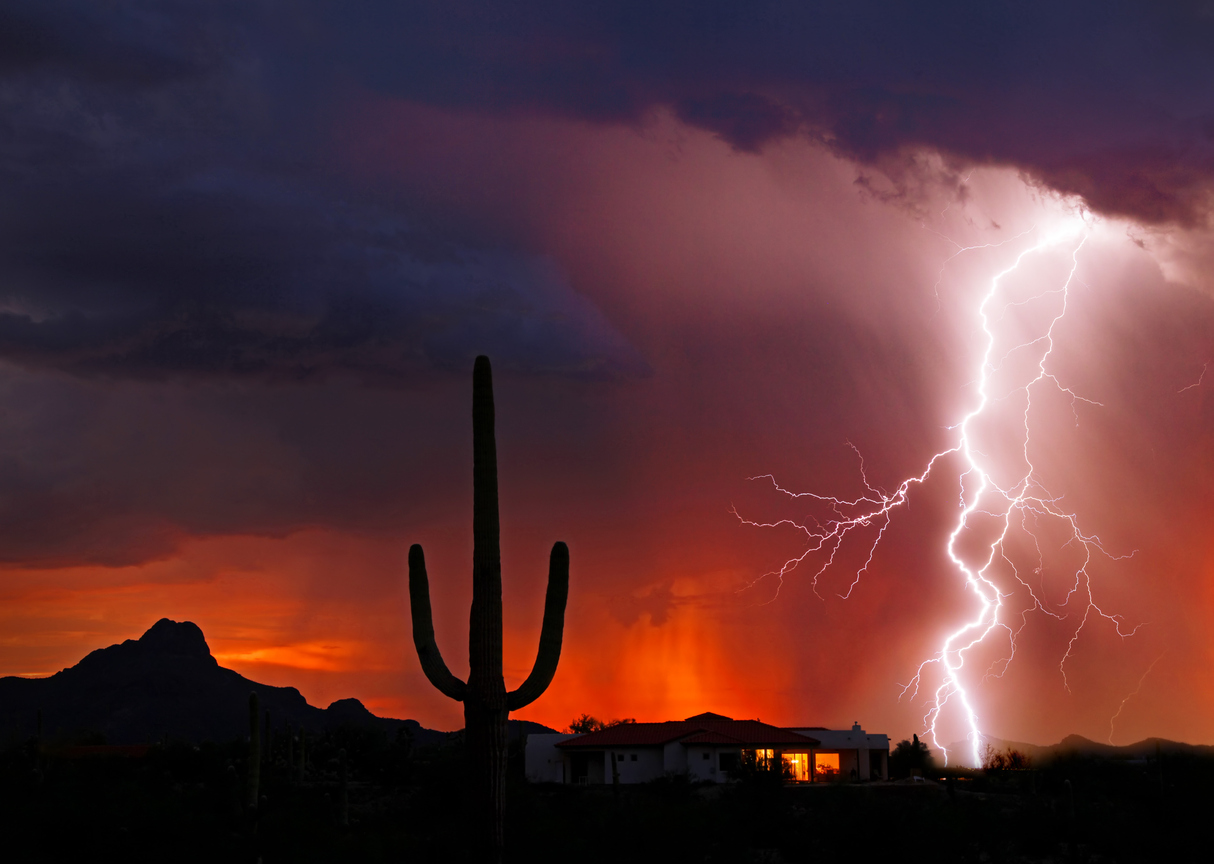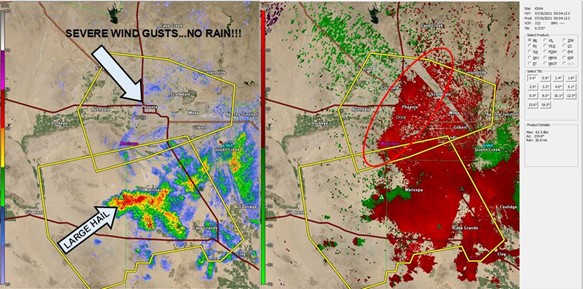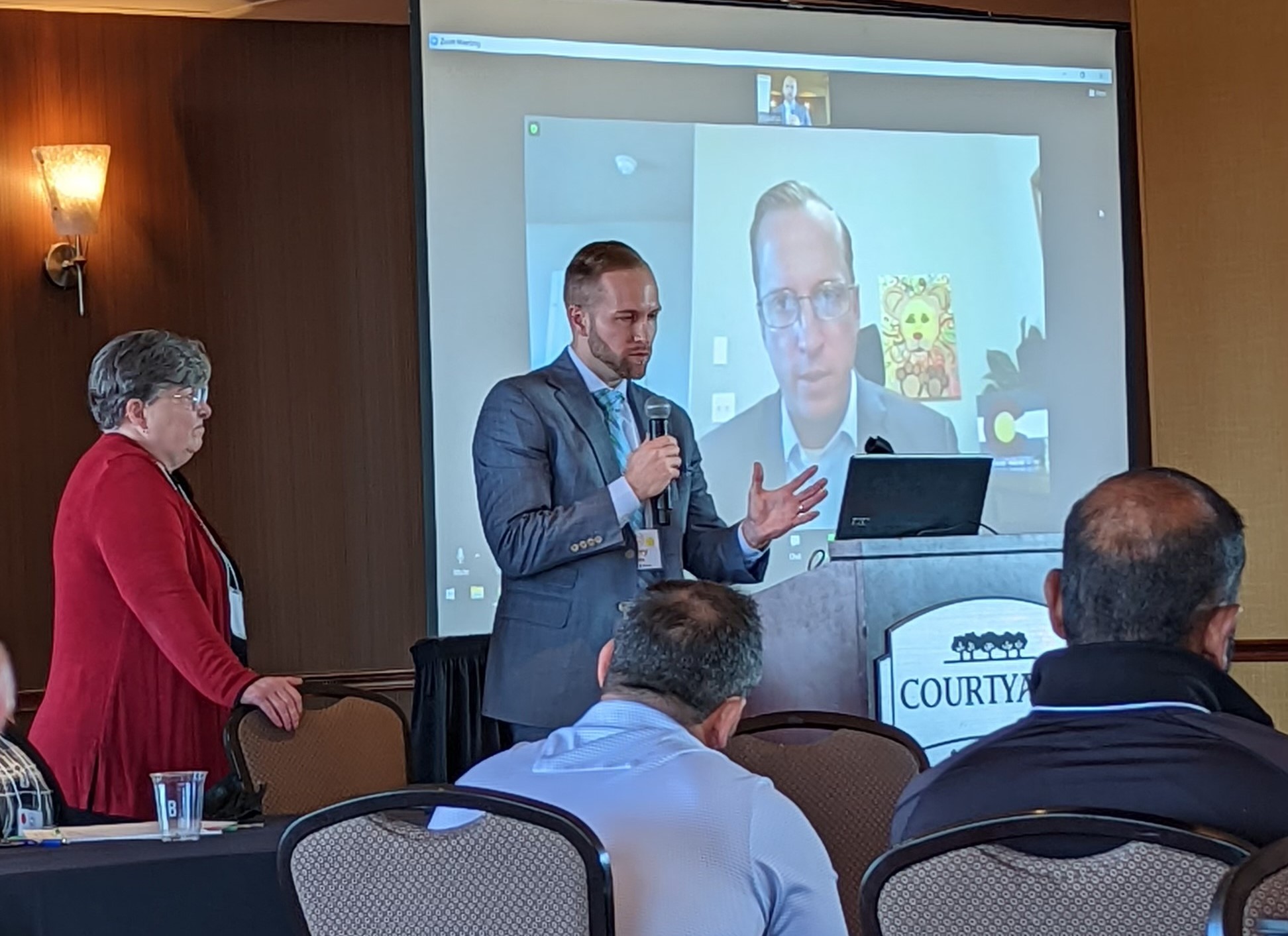While many Arizonans welcome monsoons bringing relief from the summer heat, these summer thunderstorms threaten severe damage to property in its path.
Like many other states in the U.S., Arizona has seen unusually active and severe weather during the second half of this summer. The monsoon season began early and with quite a fury, and the introduction of moisture and hot summer days has led to numerous days where large hail, damaging wind, flash floods, and even tornadoes have occurred. Merlin Law Group attorneys often retain Certified Consulting Meteorologists to provide research and reports for wind, hail, and other property damage cases. A Certified Consulting Meteorologist is an experienced and educated weather expert who has the tools and resources to provide detailed and reliable weather data and written expert reports. The information and reports they provide explain how large the hail was, how strong the winds were, or how much rain accumulated at any specific address. This kind of information is much more useful than relying on automated hail reports or a NOAA storm report many miles from the property.
The Doppler radar image below, taken during the late evening on July 9, 2021, shows two severe thunderstorm warnings in effect where the yellow polygons are located.1 The warning on the bottom of the screen is for a severe thunderstorm with heavy rain, large hail, and severe wind gusts of 58 mph or higher. What’s more interesting is the severe thunderstorm warning further north over Phoenix. This severe thunderstorm warning was issued for a thunderstorm that had no rain with it whatsoever. However, Doppler radar was detected severe winds over 58 mph in and around the city of Phoenix associated with an intense gust front that was racing westward from an old thunderstorm.2
Many professionals may not have known that very high winds were occurring with this ‘gust front,’ but because accurate and reliable information is crucial to the case outcome, Merlin Law Group uses the best weather resources, consultants, and experts, to help resolve your claims. Additionally, with monsoon season still underway, Arizona insureds should be familiar with the common perils associated with these summer storms.
Hail
The Grand Canyon State experienced an influx of hail events throughout the months of June and July. For example, an estimated 956 Arizona homes were impacted with ping pong to golf size ball hail on July 9, 2021. On July 11, 2021, an estimated 6,219 homes were impacted with golf ball to tennis ball size hail, with winds up to 70 miles per hour.3 Hail of this size coupled with high winds can lead to devastating property damage to homes and businesses.
Several factors impact the degree of damage caused by hail, such as wind speed/direction, size and density of the hail, roof type/condition, and the positioning of neighboring structures/landscaping.4 Even hail less than one inch can cause damage to your roof and other areas of your property.5 Hail damage to roofs can appear in the following forms: granule loss, cracks in the shingles, exposure and fracturing of the fiberglass mat, and weakening of the self-seal strip.6 Hail damage to your property’s roof may appear merely cosmetic; however, depending on these factors, the damage could be significant enough to penetrate your property’s roofing system, resulting in interior water damage.7
Arizona contractor Geo Roofing recommends property owners be aware of the following signs indicative of possible hail damage:8
- Mineral granules washed off from shingles into the gutters.
- Impact craters on vehicles and other visible areas on the property.
- Dents and damage to gutters and HVAC units.
Wind
In addition to hail, Arizona experienced powerful wind events throughout the summer months. Wind speeds up to 91 mph were reported on July 10, 2021, in the cities of Tucson, Chandler, and Sun Lakes, Arizona.9
Similar to hail, strong winds can result in roof leaks and other catastrophic roof damage.10 Examples of wind damage to the roofing system include:
- Missing shingles: Strong winds can pull up shingles, removing them from the roof structure.
- Lost shingle granules: Like hail, windstorms can wither off granules, an integral part of the shingles that protect the roof from ultraviolet rays.
- Shingle lift and curling: Powerful winds can cause the roof’s shingles to lift and curl, making the roof prone to water leaks.
- Roof leaks: The discovery of interior water leakage in the attic or ceiling can be indicate penetrating through the roof.11
Contact a professional roofer to conduct an inspection should you notice any of these signs.
Flash Flooding
The tremendous downpour from the monsoons resulted in flash flooding, especially in the areas impacted by recent wildfires. Wildfires change the landscape in ways that increase water and mud runoff in the burned areas. A forest burned from fires becomes unstable and unable to hold water, collecting downstream, often resulting in flash flooding.12 Arizona declared a state of emergency in mid-July after flash flooding wiped out roads and resulted in one death.
Most homeowners’ policies do not cover flood damage. Insureds are required to have flood insurance from the National Flood Insurance Program (NFIP).13 Water damage to the interior of your property from rain or snow may not be covered by your insurance policy unless the water enters through a damaged roof or wall.14 In addition, most policies exclude mold resulting from water damage.15
It is essential for Arizona policyholders to learn about their flood risk, and if necessary, purchase flood insurance to ensure protection against this costly disaster.16
Tips for Filing a Claim
If your property sustained damage as a result of these summer storms, the Arizona Department of Insurance (“AZDOI”) recommends the following tips:17
- Create a home or business inventory detailing all personal belongings and any related ownership documents (e.g., receipts, photos) to support claims for valuable items.
- Request a duplicate copy of your insurance policy and ID card if necessary.
- Document any damage by taking photographs or videos of your property.
- Contact your insurance company prior to making any repairs, cleaning, and replacement or disposal of any property.
- Take steps to prevent further damage: if emergency repairs are required, ask your insurance company what type of documentation they need.
- Make a record of what was cleaned by taking photos and videos of the damages and any emergency repairs/remediation conducted.
For additional information on Arizona monsoons, check out AZDOI Storm Resources: https://insurance.az.gov/insurance-and-storms-or-disasters.
_______________________________________
1 Courtesy of Forensic Weather Consultants. https://weatherconsultants.com/
2 Courtesy of Forensic Weather Consultants. https://weatherconsultants.com/
3 Courtesy of HailTrace. https://hailtrace.com/
4 https://www.travelers.com/resources/weather/hail/identifying-hail-damage-to-your-roof
5 https://www.superstormrestoration.com/blog/what-the-hail
6 Id.
7 https://www.georoofingaz.com/hail-damage-roof-scottsdale/
8 Id.
9 Courtesy of HailTrace. https://hailtrace.com/
10 https://restorbuilders.com/wind-damage-roof/
11 https://www.americaroofingco.com/4-signs-of-wind-damage-on-your-roof-2/
12 https://insurance.az.gov/sites/default/files/documents/files/DEMA_PR_re_flooding_after_fires_0_0.pdf
13 https://insurance.az.gov/sites/default/files/documents/files/Insurance%20and%20Storms%20Or%20Disasters.pdf
14 Id.
15 Id.
16 Id.
17 https://insurance.az.gov/sites/default/files/documents/files/Making_Repairs_After_a_Disaster%20April%202015.pdf





